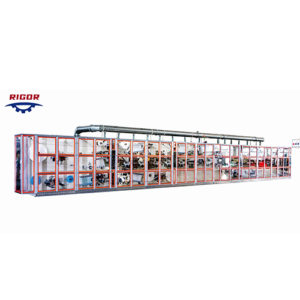The frequency of calibration checks and adjustments on a sanitary napkin machine can vary depending on factors such as the specific machine model, manufacturer’s recommendations, and the operating conditions. It’s important to follow the manufacturer’s guidelines and recommendations for calibration to ensure optimal machine performance.
However, as a general guideline, here are some considerations:
Initial Calibration: When a new machine is first installed or commissioned, it typically requires an initial calibration to set the machine parameters and ensure proper alignment and functioning of various components. This calibration is usually performed during the installation and setup process.
Regular Maintenance Schedule: Most machines have a recommended maintenance schedule provided by the manufacturer. This schedule may include routine calibration checks and adjustments. It’s advisable to follow the manufacturer’s recommended maintenance intervals, which can range from monthly to quarterly or even annually, depending on the machine’s design and usage.
Significant Changes or Events: Calibration checks may be necessary if significant changes occur in the machine’s environment or operating conditions. For example, if there are modifications made to the machine, changes in raw materials or suppliers, or shifts in production requirements, it may be necessary to recalibrate the machine to ensure accurate performance.
Performance Monitoring: Operators should also monitor the machine’s performance regularly, paying attention to any signs of deviation or inconsistencies in the produced sanitary pads. sanitary napkin machinery If there are indications of decreased product quality or variations in product specifications, it may be necessary to perform calibration checks and adjustments to bring the machine back to optimal working conditions.
It’s essential to note that the specific calibration requirements and procedures can vary between different machine models and manufacturers. The machine’s user manual or technical documentation provided by the manufacturer should be consulted for detailed instructions on calibration procedures, recommended intervals, and any specific considerations related to the machine’s design.
Regular calibration checks and adjustments help ensure the machine operates within the desired parameters, producing sanitary napkins that meet the required quality standards.
What are some common signs of deviation or inconsistencies in the produced sanitary pads?
Operators should monitor the produced sanitary pads for signs of deviation or inconsistencies to ensure the quality and conformity of the product.
Here are some common signs that may indicate issues with the produced sanitary pads:
Size Variations: Significant variations in the size of the sanitary pads, such as length, width, or overall shape, can indicate problems with the cutting and shaping mechanisms. Deviations from the desired product specifications may affect the comfort and effectiveness of the sanitary pads.
Uneven Layers: If the layers of the sanitary pad, such as the absorbent core and top-sheet, are not properly aligned or bonded, it can result in uneven distribution of materials. Operators should check for visible gaps, wrinkles, or areas where layers are not securely bonded together.
Inadequate Absorbency: Sanitary pads should have consistent absorbency throughout the product. If there are areas that appear less absorbent or fail to retain moisture properly, it may indicate issues with the absorbent core formation or bonding.
Loose or Unsecured Components: The various components of the sanitary pad, such as the top-sheet, absorbent core, and back-sheet, should be securely bonded together. Loose components or poor bonding can lead to product integrity issues and reduce the effectiveness of the sanitary pads.
Adhesive Problems: Adequate adhesive application is crucial for maintaining the shape and structure of the sanitary pads. Operators should check for signs of inadequate adhesive bonding, such as peeling edges, detached layers, or adhesives that do not hold the components together effectively.
Contamination or Foreign Objects: Operators should inspect the sanitary pads for any visible contamination or the presence of foreign objects. This can include dirt, debris, or particles that may have inadvertently entered the production process. Contamination can compromise the hygiene and safety of the sanitary pads.
Packaging Defects: If the individual wrappers or outer packaging of the sanitary pads show defects, such as improper sealing, tearing, or damaged packaging materials, it can indicate issues with the packaging process. Proper packaging is important for maintaining product hygiene and protection.
Operators should perform visual inspections and sample testing as part of quality control measures to identify any deviations or inconsistencies in the produced sanitary pads. If recurring issues are observed, it’s recommended to investigate the root causes, perform necessary adjustments or maintenance, and involve technical support or the machine manufacturer if needed.
